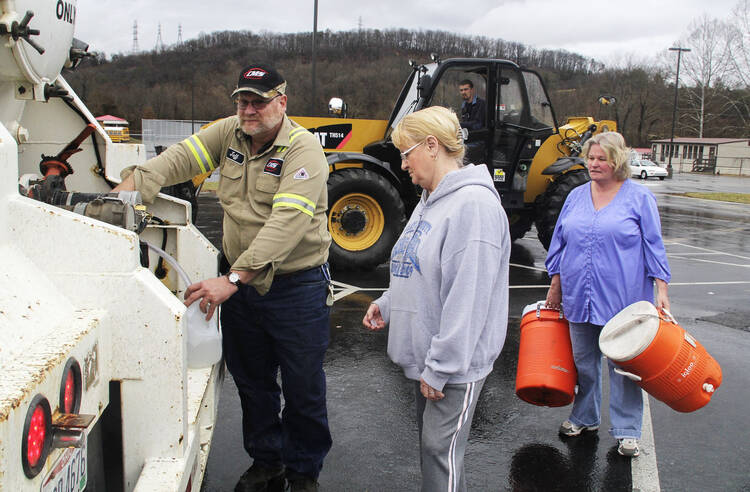Watered-Down Protection
Just a few days after a chemical spill in the Elk River on Jan. 9 contaminated the water supply of 300,000 West Virginians, a federal official said it was “perfectly appropriate” to again use the water for drinking and cooking. Don’t tell that to the 544 people who, in the two weeks following the spill, checked into hospitals with various illnesses apparently stemming from the spill. Even a state lawmaker ended up with a staph infection and nearly lost sight in her right eye after unknowingly taking a shower with the contaminated water.
As many as 10,000 gallons of chemicals leaked into the river when a storage tank used to prepare coal froze and ruptured. Freedom Industries, the company responsible, filed for bankruptcy protection barely a week after the disaster. In the aftermath, several questions must be answered. How did the spill happen, and why were the regulations regarding such operations not more forcefully applied? The incident sparked outrage, and state and federal legislators sprang into action with bills addressing this growing problem of lax enforcement and oversight.
Governor Earl Ray Tomblin has ordered the company to begin removing all 17 above-ground storage tanks from the Charleston site. The U.S. senators from West Virginia, both Democrats, are co-sponsoring a bill that would require states to strengthen inspections and put procedures in place to guard against such incidents. It will be a long time before the residents of West Virginia feel secure enough to use the tap again. Unless government officials take immediate action to address these concerns, accidents like this are bound to happen elsewhere.
Principals, Not Police
Twenty years ago, in response to a perceived uptick in violence on school grounds, Congress passed the Gun-Free Schools Act of 1994, which required an automatic one-year suspension for students who bring a firearm to school. Districts across the United States subsequently expanded this “zero-tolerance” policy, mandating suspension, expulsion and even arrest for a wide range of less serious disciplinary infractions, from drug possession to dress code violations and talking back at teachers.
The criminalization of disruptive but often age-appropriate childhood misbehavior is fueling what has become known as the “school-to-prison pipeline.” Students who are taken out of school, or experience it as a punitive and unwelcoming place, are more likely to drop out and become entangled in the criminal justice system. And there is mounting evidence of discrimination in the enforcement of these policies. Black and Hispanic students are more likely than their white peers to be suspended, expelled or arrested and that this disparity cannot be explained by differences in misbehavior.
In January the Obama administration released recommendations that spell out schools’ obligations to “avoid and redress racial discrimination” and encourage administrators to resolve conflicts through peer mediation, restorative justice programs and mental health interventions. These guidelines come at a key time. After the tragic mass shooting at Sandy Hook in 2012, voices clamored for more armed personnel at schools. But well-intentioned security measures of the past have unfairly pushed already disadvantaged students out of the classroom and have not created safer learning environments. This is an injustice we can no longer tolerate.
Ukraine on the Brink
On the bloodied streets around Independence Square in Kiev, some priests have boldly taken a direct approach to peacemaking—placing their bodies, icons and prayers between the Molotov cocktails of demonstrators and the skull-shuddering batons of riot police. President Viktor F. Yanukovych has been backpedaling furiously in recent days, acceding to the demands of the demonstrators in an effort to stay in power. But the people in the streets are not ready to forgive the brutality of his riot police, nor will they forget his efforts to suppress democratic expression.
Protesters are no longer satisfied for the president merely to step back from authoritarianism. What began as a fight over which side of the border to cleave to—greater integration with Europe or a bear hug with the Russian Federation—is accelerating into a struggle for regime survival.
As protests spread around the country, a broader civil conflict is no longer unimaginable. While the heroic presence of Ukrainian clergy along the battle lines is welcome, more help will be required from the church toward a peaceful resolution of the crisis. Sviatoslav Shevchuk, the Ukrainian Greek Catholic major archbishop of Kiev-Halych, has in fact offered to mediate negotiations between government and protest leaders, but he has properly served notice that the bishops and other church leaders in Ukraine “are, have been and will be, with the people.”
If Mr. Yanukovych is smart, he will take the archbishop up on this offer and seek a face-saving way out of this mess—even out of office if need be. As others have demonstrated, resignation from a position of high prestige and power can be the last great sacrifice a true leader can make on behalf of his people—even when they are mostly happy to see him go.








